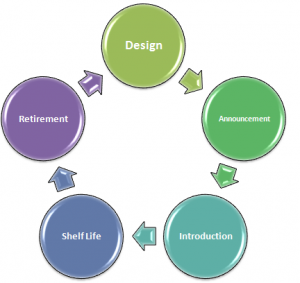
One of the most exciting times for a LEGO investor results from visiting LEGO S@H (LEGO's online storefront), looking for a particular set and suddenly realize there is a tag with the following message: "Retired Product"; Expectation and hope suddenly becomes joy.
If you are reading this article, odds are you are already familiar with the concept of EOL (End Of Line), but just in case I think it would be appropriate to summarize what it means. LEGO produces different sets along the year, and each design has a planned life cycle that only the company Execs. are aware of. Once this cycle is completed, the set goes out of production to make room for a new design, usually meaning that to acquire the already retired set a prospective buyer will need to go to the secondary market (Us!). As with anything, this decrease in supply will, hopefully, translate into an increase in set value and help the investor get a decent return of his/her investment. 
What is the problem, then? If we know that sets retire after a couple years of being in production why do we even worry about exactly when this will happen?; Well, that's the million dollar question, LEGO is now known for being very secretive AND not really consistent when it comes time to retire a particular set. This means that while an specific modular might retire 2 years after introduced, the next may last 3 or 4 years before it is pulled out of the shelves.
Having no concrete knowledge of when a set is retiring transforms into a dilemma for almost every single investor. With limited funds and an objective of maximizing profits and turnover, purchasing sets that are as close to retirement as possible becomes the most efficient way to be successful. Of course, this means that, occasionally , some investors will completely miss out on a popular set that retired before they expected OR will be left holding onto sets that will not retire for 2 or 3 more years! Tying their money, and space, for such a long period of time is definitely not the best way to make their business as efficient as possible.
But, how can we as investors have any clue about when a particular set is to be retired? Well, there is really no clear cut answer. Even though there are some clues and events that may indicate a set is nearing retirement, there is usually an understandable controversy surrounding every single one of the "leading indicators". My point is that, while I tried to collect and summarize some of the possible signs suggesting retirement, none of these should really be taking as the one and only guide when developing an investing strategy. My objective is only to list them and give mostly new investors an idea of some of the things we talk about more deeply in the forums.
LEADING INDICATORS:
1- Retiring Soon Tag
Clearly, one of the most telling events in a set's life is when LEGO S@H assigns the tag "Retiring Soon". Even though it may seem that this event pretty much guarantees a sooner than later retirement, the process is definitely not as straightforward. One of the things that may happen is a set with the tag lingering on the shelves and online storefront for months after the tag has been assigned. This could be a way for LEGO to "Clearance" a set without actually lowering the price, basically pushing potential buyers to make a purchase before the set goes away forever. Another thing to consider is that most of the products that retire never even get the tag assigned to them at all. Think of the Haunted House model that according to the majority of the investors is as close to official retirement as it is going to get. The set never had the Retiring Soon tag, it basically went from being In Stock, to Backorder and finally to Sold Out. This is a more common transition, especially with the larger exclusives.
2- Sudden, and deep, discount in official LEGO outlets
As above, this is another sign that most of the sets do not ever show. However, opposite to the Retiring Soon tag, once a set experiences a deep discount from LEGO stores and S@H (think 30% or more), it is almost a certainty that it will be retired within the next couple of weeks. As you can imagine, once a set is discounted in this manner it goes to Sold Out status in a matter of days if not hours. [img url="http://community.brickpicker.com/uploads/2014/10/Untitled1.png" cks="responsive"] The image above shows sets with both the Retiring Soon tag and the "Sale Price" discount.
3- LEGO Limits
This is one of the most controversial items on the list, and for good reason. As most of the members in the forums know, LEGO is known by limiting the amount of a same set you can purchase, especially the hard to find exclusives. Most of the time, the limits start at 5 per household and seem to be lowered as a set is nearing retirement, usually to 2 or 1. Having said that, there really is no clear evidence indicating that this pattern actually correlates to going EOL, and several sets a year completely deviate from this perceived pattern.
4- Time on the Shelves
Again, a very difficult sign to interpret. It seems that in years past LEGO was a little more predictable when it came to figuring out how long a particular set would be available for. Estimates and comments seem to place the average availability of a set at around 2 years, but as most of you know LEGO seems to have been extending the life of popular sets for 4 or more years!. However, with some exceptions *cough, DS*, once a set has been available for 3 or more years and is sharing shelf space with newer and similar models (think Modulars), it is pretty safe to assume that retirement will come sooner rather than later, making it OK to start stocking up.
5- Production Run Codes
For an introduction to Production codes, please go HERE This somewhat recent discovery can also be considered helpful to help determine potential EOL. If we as investors see a set available in 2015 that has been showing some of the other signs of retirement, and discover that the production codes indicate current inventory came from several months ago, it could lead us to believe that LEGO has stopped production of the set and is simply waiting for the last batch to be completely sold out. As with any of the other indicators, tread carefully when using production codes.
6- Retired Product Tag
Finally, the Holy Grail of LEGO investing. Once a set is assigned this tag on LEGO S@H, its death is official. This is the tag that generates more joy and excitement among the community members and, other than being able to find the set at other retailers (notably TRU & B&N), it means that any opportunity to acquire this set is pretty much gone.

Finally!
In the end, the point is that there is no sure way to determine if a set is nearing its retirement. The best we can all do is take a look at all of these signs in aggregate and share our opinions in the forums hoping for that beautiful day when the Retired Product tag shows up in LEGO S@H. Thanks for reading.
-
 3
3






Recommended Comments
There are no comments to display.
Join the conversation
You can post now and register later. If you have an account, sign in now to post with your account.
Note: Your post will require moderator approval before it will be visible.